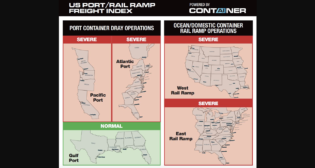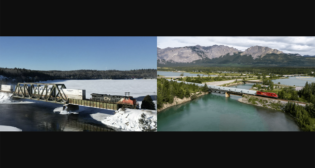
Oil train mishaps reveal tank car strengths and limitations
Written by David Thomas, Canadian Contributing EditorCN’s seven-car blaze late Saturday, Feb. 14, 2015 in a roadless area of northern Ontario, where 29 cars of a 100-car train derailed, involved CPC-1232 cars, CN confirmed to Railway Age. But a smaller event in the early hours of the same day in southern Alberta was an encouraging real-world trial of the industry’s voluntary CPC-1232 tank car design, in production since 2011.
 Sometime before dawn, a westbound Canadian Pacific train carrying crude from Western Canada jumped the tracks in the midst of a rocky debris field created in 1903 when Turtle Mountain collapsed, flooding the Crowsnest River valley with a vast flow of limestone boulders and killing 90 people. In Saturday’s incident, 12 CPC-1232 tank cars derailed, two of them toppling into the debris field and coming to rest on their sides (top two photos, by David Thomas). No crude leaked from the two tank cars, which were jacked upright and emptied of their lading into three rescue tankers dispatched from Lethbridge, along with several hopper loads of ballast to repair the track. On-site supervisors said a broken rail was responsible.
Sometime before dawn, a westbound Canadian Pacific train carrying crude from Western Canada jumped the tracks in the midst of a rocky debris field created in 1903 when Turtle Mountain collapsed, flooding the Crowsnest River valley with a vast flow of limestone boulders and killing 90 people. In Saturday’s incident, 12 CPC-1232 tank cars derailed, two of them toppling into the debris field and coming to rest on their sides (top two photos, by David Thomas). No crude leaked from the two tank cars, which were jacked upright and emptied of their lading into three rescue tankers dispatched from Lethbridge, along with several hopper loads of ballast to repair the track. On-site supervisors said a broken rail was responsible.
The CPC-1232 car is designed to contain its lading in relatively slow-speed derailments and rollovers. As the Crowsnest Pass event indicates, they work as designed in low-energy incidents. Carbuilders themselves advise that neither the CPC-1232 nor its yet-to-be-approved official successor could withstand the forces of high-speed derailments or collisions.
The flow of crude by rail through Crowsnest Pass has increased markedly under an agreement between CP and Union Pacific to smooth the interchange of unit oil trains at the border between Idaho and British Columbia.
The two Canadian oil train derailments were followed by the Feb. 16 derailment in Mount Carbon, W.Va. (about 30 miles southeast of Charleston) of a CSX train hauling 107 CPC-1232 tank cars of Bakken crude oil bound for Yorktown, Va. At least two tank cars went into the Kanawha River, and at least 17 tank cars ignited, with several exploding, sparking a house fire. Nearby residents were evacuated as state emergency response and environmental officials headed to the scene. It was the second derailment within one year on that line.
West Virginia was under a winter storm warning and getting heavy snowfall, but it’s unclear if the weather had anything to do with the derailment, which occurred about 1:20 p.m. No injuries related to the house fire or tank car fires have been reported.
Both the CSX oil train disaster in West Virginia and the nearly concurrent CN derailment and explosions in Ontario involved the newest CPC-1232 tank cars, underscoring the fact that the overwhelming risk factor is the explosivity of untreated crude oil, not the inadequacy of the disgraced DOT-111.
In both the CN and CSX derailments, the trains continued to burn and explode simultaneously through Monday as uncommonly ferocious winter weather in both locations made control difficult.
The forthcoming DOT-117 tank car specification is very much like the CPC-1232, with the probable difference of a 1/8-inch thicker tank shell. Carbuilders themselves recently warned that no amount of extra metal or sophisticated engineering will protect against breaches and fires in high-energy derailments.
The DOT-117, like its parent CPC-1232, is designed to contain its lading in slow-speed derailments and rollovers, such as the CP incident early Saturday at Crowsnest Pass in which two loaded CPC-1232 cars rolled over without breaching.
The weekend’s triplet of derailments demonstrates a profound pair of truths: First, the CPC-1232 cars performed as specified in the CP incident without spilling a drop of crude despite rolling over into a rocky debris field created 112 years ago by Canada’s deadliest landslide. Second, the CPC-1232 and its DOT-117 successor offer minimal advantage over the old DOT-111 cars in high-speed, multi-car pileups like those in Ontario and West Virginia.
Chain reaction fireballs appear to be as much a phenomena in the Ontario and West Virginia disasters as they were in the Lac-Mégantic catastrophe that killed 47 people in 2013. The DOT-111 tank cars in that event became the focus of accident investigators who noted the extreme volatility of Bakken crude from North Dakota, but chose to do nothing other than asking shippers to classify it accurately.
In a continuing run of extraordinary good fortune, both the CN and CSX derailments occurred in sparsely populated areas, and no lives were lost.
In CP’s low-key overture to the weekend’s drama, the short distance between the point of track failure and the rolled tank cars indicates the train was moving at considerably less than the 40 mph limit through the slide area, which is protected by law as the last resting place for the 80 persons whose bodies were never recovered.
The oil industry has argued that railroads are to blame for not keeping their trains on track, a contention accepted by the Federal Railroad Administration and its sister agency the Pipeline and Hazardous Materials Safety Administration, which have chosen to ignore the matter of “hot oil” being loaded directly from wells to tank cars without first cooking off the explosive dissolved gases.
Such heat treatment is routine in Texas, from where equally volatile light crude has been shipped by rail for years without a single explosive incident.
The oil industry says there is a ready market for the extracted gases in Texas, but none in North Dakota. Therefore, say the producers, the explosive gases are best shipped to refineries while still dissolved in the crude. Otherwise, they would have to be shipped away by rail or flared into the atmosphere.
The weekend events suggest that oil train explosions will continue as long as the federal governments of both countries permit the shipping of explosive crude without first stripping it of explosive gases.
Update from CN, Tuesday, Feb. 17: “CN crews at the site of this weekend’s derailment continue to work in bitter winter conditions and temperatures dipping to -31 degrees C. In those challenging conditions, today crews are working to remove the final few derailed cars from the right of way and proceed with repairs to the track. Due to the bitter cold conditions and isolated location, safety and firefighting experts have allowed the remaining controlled fire at the core of the derailment to burn. CN’s environmental team continues to work closely with the Ontario Ministry of Environment to clean up product that has spilled in the derailment area on the frozen, snow covered surface. The product has been contained in the derailment area. Mitigation, monitoring and restoration plans continue to be implemented. Ongoing air monitoring is showing that there are no safety issues for the crews working in the isolated, densely wooded area. The cause of the incident remains under investigation by the Transportation Safety Board.”



